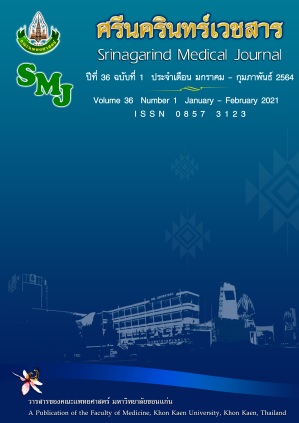Outcome of Pain Management Program in Gynecological Cancer Patients Who Received Palliative Care in Srinagarind Hospital
Keywords:
gynecological cancer; palliative care; pain managementAbstract
Background and objective: Gynecological cancer patients who received palliative care had been suffered from pain. Therefore, providing care with pain management programs and determining the outcome could manage the pain more effectively. We performed this study to assess the percentage of patients who had decreased pain equal to 50% or more and their satisfaction with pain management.
Method: A retrospective study of medical records, care records, and information systems were applied in this study. The sample were medical records of 45 gynecological cancer patients who were admitted and treated in gynecological 5B ward from January 1 - December 31, 2019. Descriptive statistic, mean, percentage, standard deviation, and their 95% CIs were used for data analysis.
Results: There were 45 gynecological cancer patients received palliative care in 2019. Most of them had initial pain score 7-10 (severe pain) and 95.6% (95% CI 84.85 - 99.46) had more than 50% reduction of pain within the first 48 hours after receiving care with the pain management program in gynecological patients receiving palliative care. Moreover, the patients were satisfied with the overall pain management at a very good level (mean 3.33, 95% CI 3.19 - 3.47).
Conclusion: The pain management program in gynecological cancer patients receiving palliative care in gynecological 5B ward of Srinagarind Hospital, Faculty of Medicine, Khon Kaen University, could effectively decrease pain.
References
2. Fitzgibbon DR, Loeser JD. Cancer pain assessment: Assessment and diagnosis. Philadelphia: Lippincott Williams & Wilkins; 2010.
3. สถาพร ลีลานันทกิจ. การควบคุมความปวดจากโรคมะเร็ง. ใน: วสันต์ ลีนะสมิต, สมเกียรติ ศรีสุพรรณดิฐ, บรรณาธิการ. ตำรามะเร็งนรีเวชวิทยา. พิมพ์ครั้งที่ 1. กรุงเทพฯ: โฮลิสติกพับลิชชิ่ง; 2542.
4. Wilkinson AM, Lynn J. Caregiving for advanced chronic illness patients. Tech Reg Anesth Pain Manag 2005; 9: 122-132.
5. Portenoy RK, Hagen NA. Breakthrough Pain: Definition, Prevalence and characteristics. Pain: 1994; 41: 153-155.
6. Bonica JJ. The Management of Pain Vol. I, 2nded. Philadelphia: Lea &Febiger; 1990.
7. นิยา สออารีย์, อารี นุ้ยบ้านด่าน, โขมพักตร์ มณีวัต. คุณภาพชีวิตและการจัดการความเจ็บปวดของผู้ป่วยมะเร็งที่มีความเจ็บปวด. สงขลา: ภาควิชาการพยาบาลอายุรศาสตร์ คณะพยาบาลศาสตร์ มหาวิทยาลัยสงขลานครินทร์; 2543. [สืบค้นเมื่อวันที่ 3 มิถุนายน 2563] จาก http://kb.psu.ac.th/psukb/handle/2553/4032
8. Cancer Unit, Khon Kaen University. Hospital-base Cancer Registry. Khon Kaen: Srinagarind Hospital, Faculty of Medicine, Khon Kaen University; 2018.
9. หอผู้ป่วย 5ข, โรงพยาบาลศรีนครินทร์. สถิติผู้ป่วยประจำปี 2561. ขอนแก่น: โรงพยาบาลศรีนครินทร์ คณะแพทยศาสตร์ มหาวิทยาลัยขอนแก่น; 2561.
10. ศรีเวียง ไพโรจน์กุล, ปาริชาติ เพียสุพรรณ์. คู่มือแนวทางการดำเนินงานศูนย์ดูแลแบบประคับประคองในโรงพยาบาลของศูนย์การุณรักษ์. พิมพ์ครั้งที่ 1. ขอนแก่น: คลังนานาวิทยา; 2560.
11. พรนภา บุญตาแสง. รูปแบบการดูแลเพื่อสนับสนุนครอบครัวในการจัดการความปวดของผู้ป่วยมะเร็งอวัยวะสืบพันธุ์สตรีที่ได้รับการดูแลแบบประคับประคอง. ขอนแก่น: โรงพยาบาลศรีนครินทร์ คณะแพทยศาสตร์ มหาวิทยาลัยขอนแก่น; 2551.
12. Mejin M, Keowmani T, Abdul Rahman S, Liew J, Lai J, Chua M, Wan IC. Prevalence of pain and treatment outcomes among cancer patients in a Malaysian palliative care unit. Pharm Pract 2019;17: 1397. doi: 10.18549/PharmPract.2019.1.1397. Epub 2019 Mar 18.
13. Tse MMY, Wong ACF, Ng HN, Lee HY, Chong MH, Leung WY. The effect of a Pain Management Program on Patients with Cancer Pain. Cancer Nurs2012; 53: 438-446.
14. รัชนีวรรณ คูตระกูล, วณิชชา เรืองศรี, อำภาพร นามวงศ์พรหม, พัชรี ยิ้มแย้ม. การพัฒนาระบบจัดการความปวดในผู้ป่วยมะเร็งระยะลุกลาม. วารสารการพยาบาลและการดูแลสุขภาพ 2561; 36: 189-197.
15. ดาริน จตุรภัทรพร, มณฑรัตน์ จินดา. ESAS (Edmonton Symptom Assessment System)ฉบับภาษาไทย. กรุงเทพฯ: คณะแพทยศาสตร์โรงพยาบาลรามาธิบดี มหาวิทยาลัยมหิดล. [สืบค้นเมื่อวันที่ 3 มิถุนายน 2563] จาก https://med.mahidol.ac.th/fammed/sites/default/files/public/pdf/esas_thai.pdf
16. นันทา เสถียรภาพงษ์, ถนอมขวัญ ทวีบูรณ์, เจือกุล อโนธารมณ์, สมถวิล โปตระนันท์, จารุณี จันท์จารุภรณ์, ปทุมภรณ์ แซ่จึง. ระดับความปวด ผลของความปวด ผลข้างเคียงของยาแก้ปวดและคุณภาพชีวิตของผู้ป่วยโรคมะเร็ง. วารสารสภาการพยาบาล 2548; 20: 13-29.
17. นงลักษณ์ สุวิสิษฐ์, สมจิต หนุเจริญกุล. การพัฒนาแบบสอบถามความพึงพอใจของผู้ป่วยต่อบริการพยาบาล. รามาธิบดีพยาบาลสาร 2554; 17: 264-277.
18. จิตติพร ยุบลพริ้ง. โครงการใช้ผลงานวิจัยทางการพยาบาล เรื่อง แนวปฏิบัติการพยาบาลเพื่อลดความปวดในผู้ป่วยมะเร็ง. กรุงเทพฯ: คณะพยาบาลศาสตร์ มหาวิทยาลัยมหิดล; 2549.
19. เดือนเพ็ญ ห่อรัตนาเรือง, ปิยะพร บุญแสงเจริญ, วิมลรัตน์ กฤษณะประกรกิจ. การบริการระงับปวดในผู้ป่วยเด็กในโรงพยาบาลศรีนครินทร์. ศรีนครินทร์เวชสาร 2547; 19: 141-145.
20. Bruera E, Paice JA. Cancer pain management: safe and effective use of opioids. Am Soc Clin Oncol Educ Book 2015; e593-e599. doi:10.14694/EdBook_AM.2015.35.
21. สมพร ชินโนรส, มยุรี จิรภิญโญ, ขวัญจิตร์ ปุ่นโพธิ์. การจัดการกับความปวดและความพึงพอใจต่อการจัดการกับความปวดในผู้ป่วยที่รับการผ่าตัดมดลูกออกทางหน้าท้อง. รามาธิบดีพยาบาลสาร 2552; 15: 327-343.
22. ภาวดี วิมลพันธุ์, พรทิวา คำวรรณ. ประสิทธิผลการใช้แนวปฏิบัติทางการพยาบาลเพื่อจัดการกับอาการปวดในผู้ป่วยมะเร็งทางเดินอาหาร. พยาบาลสาร 2556; 40: 85-96.




